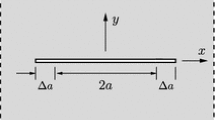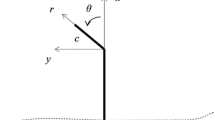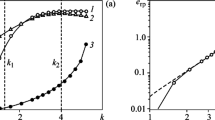Abstract
This article discusses the characterization of fracture process zone at the tip of a blunt crack in elastoplastic materials under mixed mode loading. The analysis includes the description of elastoplastic zone geometry around the blunt crack tip for predicting crack growth direction. The deformed zone appearing at the crack front is described by presenting a criterion based on the subloading surface concept falling within the framework of unconventional plasticity. The mixed mode crack propagates along the minimum value of the elastoplastic region. The present solutions are reduced to those previously reported in literature, when the elastic perfectly plastic material is considered.
Similar content being viewed by others
References
Pook, L.P., The effect of crack angle on fracture toughness. Eng. Fracture Mech., 1971, 3(3): 205–218.
Eftis, J. and Subramonian, N., The inclined crack under biaxial load. Eng. Fracture Mech., 1978, 10(1): 43–67.
Chou, C.T. and Kuo, C.P., An analysis of the mixed-type stress field near a crack-tip region. Eng. Fracture Mech., 1982, 16(1): 35–46.
Papadopoulos, G.A., The stationary value of the third stress invariant as a local fracture parameter (Det.-criterion). Eng. Fracture Mech., 1987, 27(6): 643–652.
Papadopoulos, G.A., Crack initiation under biaxial loading. Eng. Fracture Mech., 1988, 29(5): 585–598.
Papadopoulos, G.A., New concepts on the Det.-criterion. Eng. Fracture Mech., 1989, 33(2): 283–293.
Shlyannikov, V.N. and Braude, N.Z., A model for predicting crack growth rate for mixed mode fracture under biaxial loads. Fatigue Fract. Engng. Mater. Struct., 1992, 15(9): 825–844.
Golos, K. and Wasiluk, B., Role of plastic zone in crack growth direction criterion under mixed mode loading. Int. J. Fracture, 2000, 102(4): 341–353.
Jing, P., Khraishi, T. and Gorbatikh, L., Closed-form solutions for the model II crack tip plastic zone shape. Int. J. Fracture, 2003, 122(3): L137–L142.
Li, H. and Chandra, N., Analysis of crack growth and crack-tip plasticity in ductile materials using cohesive zone models. Int. J. Plasticity, 2003, 19(6): 849–882.
Erdogan, F. and Sih, G.C., On the crack extension in plates under plane loading and transverse shear. J. Basic Eng., 1963, 85(4): 519–527.
Sih, G.C., Some basic problems in fracture mechanics and new concepts. Eng. Fracture Mech., 1973, 5(2): 365–377.
Sih, G.C., Strain-energy-density factor applied to mixed mode crack problems. Int. J. Fracture, 1974, 10(3): 305–321.
Kong, X.M., Schluter, N. and Dahl, W., Effect of triaxial stress on mixed-mode fracture. Eng. Fracture Mech., 1995, 52(2): 379–388.
Theocaris, P.S. and Andrianopoulos, N.P., The Mises elastic-plastic boundary as the core region in fracture criteria. Eng. Fracture Mech., 1982, 16(3): 425–432.
Theocaris, P.S. and Andrianopoulos, N.P., The T-criterion applied to ductile fracture. Int. J. Fracture, 1982, 20: R125–R130.
Khan, S.M.A. and Khraisheh, M.K., Analysis of mixed mode crack initiation angles under various loading conditions. Eng. Fracture Mech., 2000, 67(5): 397–419.
Theocaris, P.S., Kardomateas, G.A. and Andrianopoulos, N.P., Experimental study of the T-criterion in ductile fracture. Eng. Fracture Mech., 1982, 17(5): 439–447.
Papadopoulos, G.A. and Poniridis, P.I., Crack initiation from blunt notches under biaxial loading. Eng. Fracture Mech., 1988, 31(1): 65–78.
Yan, X., Zhang, Z. and Du, S., Mixed-mode fracture criteria for the materials with different yield strengths in tension and compression. Eng. Fracture Mech., 1992, 42(1): 109–116.
Ukadgaonker, V.G. and Awasare, P.J., A new criterion for fracture initiation. Eng. Fracture Mech., 1995, 51(2): 265–274.
Harmain, G.A. and Provan, J.W., Fatigue crack-tip plasticity revisited—the issue of shape addressed. Theor. Appl. Fract. Mech., 1997, 26: 63–79.
Qiang, H.F., Lu, N. and Liu, B.J., Unified solutions of crack tip plastic zone under small scale yielding. J. Mech. Eng., 1999, 35(1): 34–38.
Zhang, Y., Qiang, H.F. and Yang, Y.C., The unified solutions to mixed mode crack tip under small scale yielding. J. Mech. Eng., 2007, 43(2): 50–54.
Yu, M.H., Advances in strength theories for materials under complex stress state in the 20th century. J. Appl. Mech., 2002, 55(3): 169–218.
Wu, X.F. and Dzenis, Y.A., Closed-form solution for the size of plastic zone in an edge-cracked strip. Int. J. Eng. Sci., 2002, 40(15): 1751–1759.
Wasiluk, B. and Golos, K., Prediction of crack growth direction under plane stress for mixed-mode I and II loading. Fatigue Fract. Engng. Mater. Struct., 2000, 23(5): 381–386.
Khan, S.M.A. and Khraisheh, M.K., A new criterion for mixed mode fracture initiation based on the crack tip plastic core region. Int. J. Plasticity, 2004, 20(1): 55–84.
Khan, S.M.A. and Khraisheh, M.K., The anisotropic R-criterion for crack initiation. Eng. Fract. Mech., 2008, 75(14): 4257–4278.
Kaminsky, A.A., Kurchakov, E.E. and Gavrilov, G.V., Study of the plastic zone near a crack in an anisotropic body. Int. Appl. Mech., 2006, 42(7): 749–764.
Xin, G., Hangong, W., Xingwu, K. and Liangzhou, J., Analytic solutions to crack tip plastic zone under various loading conditions. European Journal of Mechanics-A/Solids, 2010, 29(4): 738–745.
Drucker, D.C., Conventional and unconventional plastic response and representation. Appl. Mech. Rev. (ASME), 1988, 41(4): 151–167.
Hashiguchi, K., Constitutive equations of elastoplastic materials with elastic-plastic transition. J. Appl. Mech. (ASME), 1980, 47(2): 266–272.
Hashiguchi, K., Subloading surface model in unconventional plasticity. Int. J. Solids Struct., 1989, 25(8): 917–945.
Hashiguchi, K., Saitoh, K., Okayasu, T. and Tsutsumi, S., Evaluation of typical conventional and unconventional plasticity models for prediction of softening behavior of soils. Geotechnique, 2002, 52: 561–573.
Hashiguchi, K. and Protasov, A., Localized necking analysis by the subloading surface model with tangential-strain rate and anisotropy. Int. J. Plasticity, 2004, 20(10): 1909–1930.
Khojastehpour, M., Murakami, Y. and Hashiguchi, K., Antisymmetric bifurcation in an elastoplastic cylinder with tangential plasticity. Mechanics of Materials, 2006, 38(11): 1061–1071.
Khojastehpour, M. and Hashiguchi, K., Axisymmetric bifurcation analysis in soils by the tangential-subloading surface model. J. Mech. Phys. Solids, 2004, 52(10): 2235–2262.
Khojastehpour, M. and Hashiguchi, K., Plane strain bifurcation analysis of soils by the tangential-subloading surface model. Int. J. Solids and Struct., 2004, 41(20): 5541–5563.
Creager, M. and Paris, P.C., Elastic field equations for blunt cracks with reference to stress corrosion cracking. Int. J. Fracture, 1967, 3(4): 247–252.
Anderson, T.L., Fracture Mechanics: Fundamentals and Applications. Second ed., CRC Press, USA, 1995.
Author information
Authors and Affiliations
Corresponding author
Rights and permissions
About this article
Cite this article
Khojastehpour, M. Blunt crack-tip elastoplastic zone of mixed mode fracture. Acta Mech. Solida Sin. 27, 531–541 (2014). https://doi.org/10.1016/S0894-9166(14)60061-6
Received:
Revised:
Published:
Issue Date:
DOI: https://doi.org/10.1016/S0894-9166(14)60061-6




